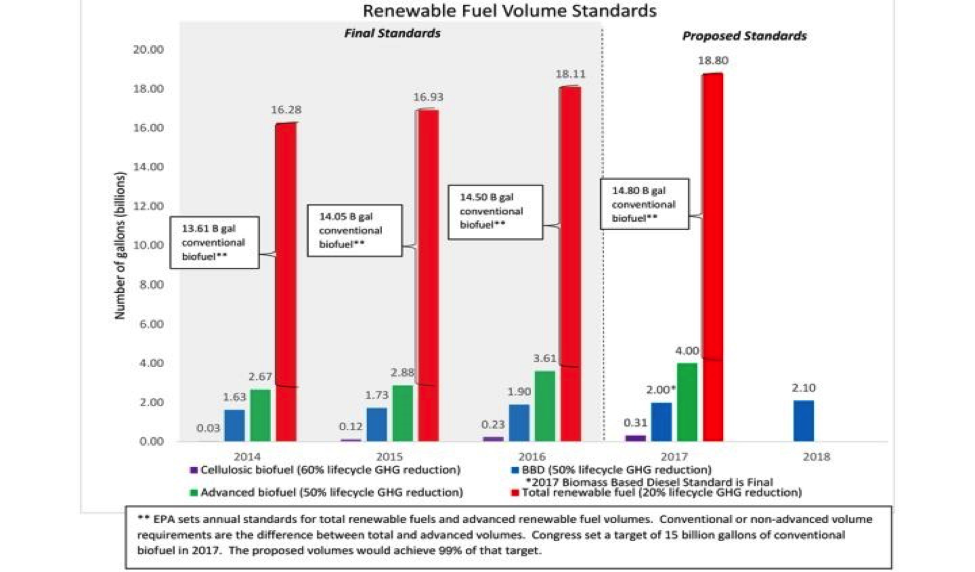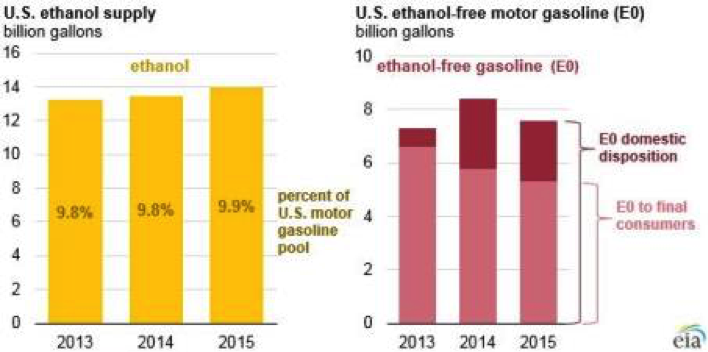The Environmental Protection Agency (EPA) has the legal authority to modify the Renewable Fuel Standard mandate levels if the legislated requirements are not attainable. When Congress passed the levels of renewable fuels in the Energy Independence and Security Act of 2007, it was expected that gasoline demand would continue to increase, so they mandated an increasing level of renewable fuels to match the increased levels of motor fuel demand expected. However, gasoline demand has actually fallen during recent years, making the levels Congress mandated non-attainable and unnecessary.
Last November, the Environmental Protection Agency (EPA) mandated 18.11 billion gallons of renewable fuels (corn-based ethanol and other biofuels) to be blended in 2016. This is 7 percent higher than in 2015 and over 10 percent of this year’s expected gasoline production. In other words, 18 billion gallons of ethanol is over the 10 percent blend wall.[i] The problem with exceeding the blend wall or even just reaching it is that many automobile manufacturers will not warranty vehicles that use more than 10 percent ethanol and many small engines (e.g. lawn mowers) also limit ethanol mixtures and actually prefer pure gasoline. For that reason, it has been recommended that the renewable fuel share not exceed 9.7 percent.[ii] But, EPA ignored that recommendation in setting the renewable fuels share for 2016, which is at 10.1 percent.
This month, the EPA proposed that 18.8 billion gallons should be blended with motor fuels in 2017— 3.8 percent higher than the 2016 level. Here again, the level exceeds the blend wall, with an expected share of 10.44 percent.
At the same time, 18.8 billion gallons is less than the volume mandated by the RFS. EPA explained that the lower-than-mandated level is needed because of slower-than-expected development of certain types of non-corn biofuels and constraints in the market place. EPA is expected to issue the final rule later this year after the close of a public comment period.[iii]
Source: http://ngtnews.com/epa-proposes-slight-increases-in-renewable-fuel-standards/
Biofuels by Type
EPA’s proposal for 2017 is for total renewable fuels to be 18.8 billion gallons. Of that, 14.8 billion gallons can be conventional biofuels (corn-based ethanol), 4 billion gallons is to be advanced biofuels, and 312 million gallons is to be cellulosic ethanol. That is up from the 2016 level of 18.11 billion gallons of total renewable fuels, of which 14.5 billion gallons is corn based ethanol, 3.61 billion gallons is advanced biofuel, and 230 million gallons is cellulosic ethanol. Biomass-based diesel requirements were previously set to 2 billion gallons in 2017, from 1.9 billion gallons in 2016. In 2018, EPA proposes increasing biomass-based diesel requirements to 2.1 billion gallons. Biodiesel is primarily sourced from vegetable oil.
Costs Increase When Levels are Not Met
Refiners that are not able to meet the renewable fuel requirement must purchase Renewable Identification Numbers (RINs)–credits that allow them to make up the difference between what is mandated and what is actually used. After EPA announced the renewable fuels requirement for 2016, RIN costs increased by over 50 percent–from 54.5 cents per gallon on November 30 to 85 cents per gallon on December 1. More recently, they have been trading at around 75 cents per gallon.[iv]
With oil prices being down, ethanol is now trading for prices that are higher than gasoline. Consequently, refiners either have to pay the premium for ethanol or purchase RINs—either way they are paying a penalty for a government program that was supposed to help, instead of hinder, the gasoline market.
The legislation sets mandated levels of biofuels through 2022 when Congress envisioned 36 billion gallons of renewable fuels being consumed, of which 15 billion gallons was to be corn-based while the rest was to be advanced biofuels. The 21 billion gallons of advanced biofuels is unlikely to be produced since the cellulosic ethanol industry did not take off as Congress envisioned. After 2022, Congress indicated that EPA should set targets at its discretion. Unforeseen problems with the Renewable Fuel Standard—the blend wall and the lack of cellulosic ethanol production, which was expected to reduce emissions at a greater level than corn-based ethanol—have made many critics call for its total or partial repeal.
10 Percent Blend Wall Reached in 2015
According to the Energy Information Administration (EIA), over 95 percent of all fuel pumped into American vehicles in 2015 contained 10 percent ethanol. With EPA’s higher mandated levels, the next step must be a greater amount of a higher ethanol blend. With almost all U.S. gasoline now being sold as E10, the only way to increase ethanol use in the motor vehicle fleet is to adopt fuel blends containing a higher volume of ethanol, such as E15 and E85. E85 can only be used in flex fuel vehicles. EPA believes that E15 can be used in vehicles of model year 2001 and later models despite many automobile manufacturers disputing that finding and not warrantying cars that use E15.[v]
Source: EIA, http://www.eia.gov/todayinenergy/detail.cfm?id=26092
In the final RFS rules issued in November 2015, the EPA estimated 320 million gallons of E15 and 200 million gallons of E85 would be used in 2016. These values together represent just 0.4 percent of the 142 billion gallons of fuel expected to be consumed by vehicles and other equipment with gasoline-burning engines in 2016, according to EIA’s Short-Term Energy Outlook.[vi]
It is not clear why flex fuel vehicle owners would use E85 over E10, even if it were available to them, since on a Btu equivalent basis, it is more expensive. Average E10 prices in the United States are $2.28 a gallon and average E85 prices are $1.84 per gallon. But, adjusted for its lower energy content, E85 costs the consumer $2.58 per gallon.
Conclusion
Congress and the Bush Administration in 2007 made estimates of what they expected the future to look like with respect to gasoline consumption and biofuel production, and set numbers into law. They were wrong about both futures. The EPA’s mandate for renewable fuels blended into transportation fuels in 2016 and its proposal for 2017 forces more ethanol into the market than the current infrastructure can handle, which increases fuel costs for Americans. Rather than exceed the blend wall, biofuel volumes should be capped to match current market realities and lessen the impact of the renewable fuel standard on consumers.
[i] Fuel Fix, Ethanol Blending Shrinking Margins for Refiners, May 13, 2016, http://fuelfix.com/blog/2016/05/13/ethanol-blending-shrinking-margins-for-refiners/
[ii] Green Car Reports, New House bill seeks to limit ethanol in gasoline to current usage, May 18, 2016, http://www.greencarreports.com/news/1104011_new-house-bill-seeks-to-limit-ethanol-in-gasoline-to-current-usage
[iii] Washington Times, EPA’s move to raise ethanol mix in gasoline fuels alarm over engine damage, May 20, 2016, http://www.washingtontimes.com/news/2016/may/20/epas-move-raise-ethanol-mix-gasoline-fuels-alarm-o/
[iv] Platts, US refiners feel the pinch of Renewable Fuel Standard costs: Fuel for Thought, May 16, 2016, http://blogs.platts.com/2016/05/16/us-refiners-renewable-fuel-standard-costs/
[v] Energy Information Administration, Almost All U.S. Gasoline Is Blended With 10% Ethanol, May 4, 2016, http://www.eia.gov/todayinenergy/detail.cfm?id=26092
[vi] Oil Price, U.S. Gasoline Now Contains 10 Percent Ethanol, May 4, 2016, http://oilprice.com/Latest-Energy-News/World-News/US-Gasoline-Now-Contains-10-Percent-Ethanol.html





